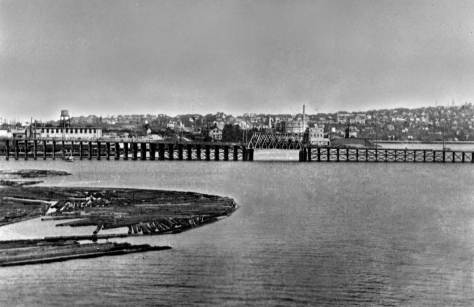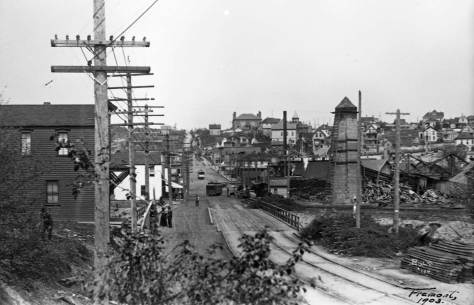

THE JOHNSON HOME at 169 ERTURIA
Like any mill town “Greater Fremont” was once scattered with modest residences. Of the many that survive, a few have been mercifully spared the trauma of remodeling and appear today much as they did in the 1890s.
One example is the Johnson home at 169 Etruria near the south end of the Fremont Bridge. This is the smaller section of Fremont that climbs the north slope of Queen Anne Hill and somewhere along the way leaves the mill town for the hill town. (Since I last visited the site the home in 1991 it has been effectively walled away from the sidewalk and street, as testified with Jean’s recent return to Etruria.)
Ion Johnson married Ellen Maud O’Grady in 1893. They had a son, Ralph Waldo, who purchased a camera and built a darkroom in the backyard shed. The first of Ralph Johnson’s pictures above is of the family home. As noted it was scanned from a photo album that survives with the home. The darkroom-shed is also still standing – or rather was when last I visited 19 years ago.
Johnson’s album is packed with rare glimpses into the life of his neighborhood during the construction years of the ship canal and the bascule Fremont Bridge. The album is also a confession of one young adult male’s interests in boats, women, and motorcycles. The album’s last pages are filled with snapshots Johnson made as an infantryman in France, or on his way to France. Badly gassed in the trenches, he was predisposed to respiratory illnesses the rest of his life. He died of pneumonia in 1980 at age 87.


By his friends’ descriptions, Ralph Waldo was a natty man who loved opera, the theater and dining out. Good-humored and generous, he was active in the Puget Sound Maritime Historical Society and sometimes wrote for its publication, the Sea Chest.

As an adolescent Ralph briefly worked as a candy boy on the celebrated Puget Sound steamer Yosemite until his mother overheard some of the language used on deck. Waldo’s father, lon, died in the early 1920s, but his mother continued to live in the family home until her death in the mid-1940s. Thereafter Waldo’s only sibling, his younger sister Beryl, lived there until her death left the little home to Waldo alone. Heirless, Ralph Waldo Johnson willed his family home to Margaret Wilhelmi, the daughter of a close friend. She has protected (still in 1991) both the little residence’s architectural integrity and Waldo’s revealing photo album.
(Next we visit the home of Ralph’s neighbor Annie Craig, and conclude with a sample of other scenes pulled from Johnson’s surviving album of youthful snapshots.)
[PLEASE CLICK to ENLARGE]
ANNIE CRAIG’S HOME on FLORENTIA
Ralph Waldo captions this recording of his neighbor, “Mrs Craig, 1915.” However terse, this is a good lead. The Polk Directory for 1915 reveals that an Annie Craig, widow of Charles, lived at 200 Florentia at the north end of Queen Anne Hill near the Fremont bridge. The woman standing here with her birds is surely that Annie Craig. She lived across the alley from Ralph Waldo’s home on Etruria, and her young neighbor took this snapshot and printed it in his darkroom shed on the alley.
Searching back and forth from 1915 through other Polk directories reveals that Anna and Charles Craig moved to Florentia in the late 1890s from a home on the other side of Queen Anne Hill, at 232 First Ave. W., about three blocks north of Denny Way. Charles is first listed there in 1890. His 1899 registry is more elaborate; he is tabbed as a tallyman for the Stetson and Post Lumber Company. That 1899 recording is ‘Charles Craig’s last. Following directories list Anna (or Annie) Craig as his widow.
In the 1909 Polk Directory, Anna is identified as vice president for the Flatow Laundry Company on First Avenue in Belltown. The directory also reveals that Isador Flatow, the president, lived at 69 Etruria, or just up the alley from Annie.
After that listing, there is nothing to quickly learn about Annie Craig except that she nurtured a most inviting flower garden and had more than one parrot to adorn it.
“Annie Craig (widow Chas) 200 Florentia” is last listed in the 1921 city directory.






















On the last photo in the series, the photo in the upper right-hand corner of the group is the Minnesota state capitol in St. Paul.
Thanks Matthew. I’ll include your clarification in the body of the story directly above.